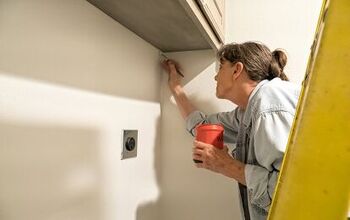How To Paint A Fiberglass Door (Step-by-Step Guide)

Insulated fiberglass exterior doors are notoriously durable and long-lasting. Similar to steel, fiberglass is more energy-efficient and secure than conventional wood constructions. In addition to their strength, they also require little to no maintenance.
Fiberglass doors are designed to mimic a wood finish without the possibility of warping. Aside from being susceptible to fading, they come with very few disadvantages. Although fiberglass is one of the more expensive options for exterior doors, they are well worth the premium price. Their energy efficiency lowers your utility bills, effectively repaying their asking price several times over.
With such a wide variety of staining and painting options available, fiberglass doors are very versatile and can easily fit within your design aesthetic. Whether you’re looking for ways to weather-seal your front entrance, or want to give your fiberglass door a general refresh, the painting process is much like you would paint a wood door (without the need for sanding first).
As long as you select the right paint and perform the necessary preparation steps, you’ll be able to achieve a very successful paint job. Examine the steps below for efficiently and effectively painting your fiberglass door.
Do You Need Painting or Staining Services?
Get free, zero-commitment quotes from pro contractors near you.

Selecting the Right Paint
Before you begin any preparation or painting, you need to choose the appropriate paint for the job. When you head to your local home improvement center, you’ll have three types of fiberglass paints to choose from: high gloss, regular gloss, and low gloss. Each of these types of paint comes with its own individual advantages and disadvantages. However, if you want your door to stand out, you may consider opting for a high-gloss paint.
If you want a more muted look, go for the regular gloss paint, and for the most conservative option select low gloss. Regardless of the paint type, you want to ensure that it is an exterior paint as these paints exceptionally resist weathering.
Additionally, you should avoid using oil-based or melamine paints on your fiberglass door. Instead, choose a polyester, 100% acrylic, epoxy, or polyurethane paint. The chemical properties in these paints will not deteriorate the structural integrity of the fiberglass.
For one final note, make sure that the paint you select has the same base as your door’s fiberglass resin. For instance, if the fiberglass is a polyester-resin, use a paint that is polyester based and an epoxy-based paint for epoxy resin fiberglass. If you’re unsure of the resin in your fiberglass door, consult the instructions from the manufacturer for this information.
Painting A Fiberglass Door
Step One: Initial Preparation
As always you want to wear the appropriate protective gear when you’re working with paint. You should put on safety glasses along with a pair of gloves. These gloves will prevent soiling the fiberglass door with oil from your hands.
Painting your fiberglass door will be much easier if you lay it out in a horizontal, flat position on a surface that is both clean and padded. While this is not required and you can finish the door in virtually any position, it will help to simplify the process.
Just as you would with any other paint job, make sure that your work area has the necessary ventilation. Open windows and doors and bring in a box fan to increase airflow to the space. You may also consider wearing a face mask or respirator to protect yourself from the paint fumes.
Quick Tip: Never paint exterior surfaces when the outside temperature is above 90 or below 50 degrees Fahrenheit. These harsh temperatures will have a negative impact on your paint job.
Step Two: Removing Weather-Stripping
Consult the manufacturer’s instructions for removing all the weatherstripping from your fiberglass door. For best results, use a soft-bristled brush for removal. If you have any weatherstripping left over, it can be cleared off using a soft, dry cloth. Ensure that the door is completely free of weatherstripping before you move onto the next step.
Step Three: Wash the Door
Once you’ve put on your protective gear, positioned the door, and removed the weatherstripping, you’ll want to give it a good clean. Use a clean, lint-free cloth to remove dust and any foreign debris. For light cleaning, you can use a solution of one-part vinegar to 10 parts water. Or, you can mix together dish soap and warm water. If you require any tough dirt removal, use isopropyl alcohol.
Start at the top of the door, working your way down and continuously flipping over your cloth to achieve the most thorough clean. Then, use a clean damp sponge to rinse and remove any soap or vinegar residue. Allow a suitable amount of time, about 2 to 3 hours, for the door to dry completely before you proceed.
Step Four: Mask Off
Before you start painting, you’ll want to cover and protect all the areas that surround the fiberglass door. Use painter’s tape to mask off the door jam, doorknob, door hardware, and any window glass. This will help shield these areas from any stray paint droplets.
If instead of laying the door out flat you’ve decided to paint it still in its frame, use newspaper or a drop cloth to cover the floor underneath. Dry rags or old clothing will also suffice if you don’t have newspaper or a drop cloth on hand.
Step Five: Start Applying the Primer
Best practice when painting is to always adhere to the manufacturer’s recommendations in regards to paint and primer. While some doors may not require a primer, they can all benefit from a good-quality primer. It will make it much easier for the topcoat of paint to adhere properly and create a long-lasting finish.
Stir the primer thoroughly for a few minutes and then pour some of it into a paint tray. To apply the primer, you can use a paint spray gun or a painter’s synthetic brush. The synthetic brush is more recommended though, as spray guns notoriously waste a lot of paint and can be difficult to achieve a smooth finish if you’re not an expert painter.
Start by dipping your brush into the primer, wipe off the excess, and apply to the door’s four edges.
Quick Tip: For best results, keep an assortment of different-sized synthetic brushes on hand while painting. If you experience difficulty covering an area of the door with a specific brush, choose a different size.
Step Six: Prime the Exterior Side of the Door
If your fiberglass door has a wood-grain finish, you’ll want to follow this grain pattern while priming and painting the exterior side. The faux grain texture generally runs vertically on vertical sections of the door, and horizontally along the top and bottom of the door (including above and below any windows).
Avoid applying the primer in thick globs and use thin, even coats instead. If you apply primer too thickly you will deteriorate the profile and details of your fiberglass door. Allow the indicated amount of time for the primer to dry before you move onto painting.
Step Seven: Apply the Paint
With your fiberglass door prepped and primed, you can start painting. Though, make sure that you wait until the primer is fully dried first. Apply the first coat of paint as evenly and smoothly as possible, following the faux wood grain as indicated in the previous step.
Wait until the first coat has cured before you apply any additional coats. In most cases, you’ll be able to achieve the desired finish on your fiberglass door in two coats of paint. Let the door dry overnight before you remove the tape and continue on to the other side.
Step Eight: Repeat For the Interior Side of the Door
Once the exterior side of your fiberglass door has cured completely, you can flip it over and begin the work on the other side. Simply repeat the previous exterior side steps outlined above for the interior side.
Start by covering all the necessary areas with painter’s tape. Then, apply the primer along all four edges, following the wood-grain pattern. Once the primer has dried, you can proceed with your two coats of paint allowing plenty of drying time in between.
Do You Need Painting or Staining Services?
Get free, zero-commitment quotes from pro contractors near you.

Related Questions
Do you need to remove a fiberglass door to paint it?
Although removing your fiberglass door from its frame to paint it will provide the best coverage, it can be difficult to rehang after the task is done. Instead, you can choose to paint the door while it is still attached. In fact, painting a fiberglass door without removing it is generally a much faster and simpler paint job.
What is the best paint for fiberglass exterior doors?
The best type of paint for fiberglass exterior doors is water-based latex paint that is formulated for exterior use. Lacquer is never recommended for fiberglass materials and while oil paint won’t damage the surface, it is much more difficult to paint with.
Is it better to paint or stain fiberglass doors?
If your fiberglass exterior door is exposed to frequent direct sunlight it should be painted instead of stained. Although either finish can be used for textured fiberglass doors, they generally look more appealing when stained. Also, if you’re looking to achieve a wood look on your fiberglass door, staining can help accomplish this.

Jessica considers herself a home improvement and design enthusiast. She grew up surrounded by constant home improvement projects and owes most of what she knows to helping her dad renovate her childhood home. Being a Los Angeles resident, Jessica spends a lot of her time looking for her next DIY project and sharing her love for home design.
More by Jessica Stone



























